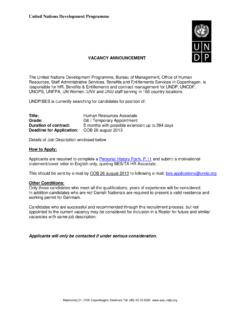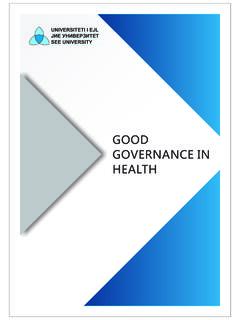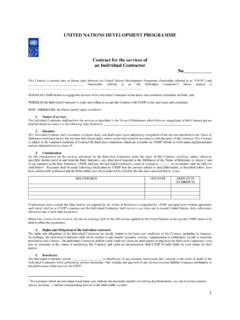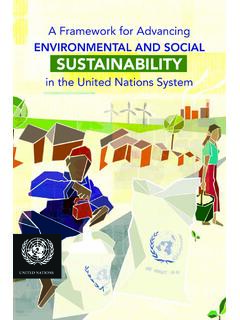Transcription of Environmental Management Tools and Techniques
1 ROYAL GOVERNMENT OF BHUTAN.. NATIONAL ENVIRONMENT COMMISSION. Nati . ion .. iss o lE.. na .. m nvi om .. ron ment C. Environmental Management Tools Environmental Management Tools and Techniques and Techniques A Learning Material National Environment Commission Box 466, Thimphu, Bhutan NATIONAL ENVIRONMENT COMMISSION. Environmental Management Tools and Techniques A Learning Material Table of contents Environmental Management CONCEPTS .. 1. WHAT IS Environmental Management ? .. 1. WHY UNDERTAKE Environmental Management ? .. 3. Cost savings ..3. Ensuring legislative 5. Anticipating future legislation .. 5. Reduced Environmental Meeting supply chain requirements .. 6. Improved relations with regulators .. 6. Improved public image and community relations .. 6. Increased market opportunities .. 6. Employee Environmental Management PRINCIPLES .. 7. GUIDING PRINCIPLES FOR Environmental Management .
2 7. Precautionary 7. Uncertainty Principle .. 7. Intra-generational Equity .. 8. Inter-generational Equity .. 8. Recognition and Preservation of Diversity .. 8. Internalization of Costs .. 8. The Polluter Pays Principle .. 8. The Prevention Principle .. 9. The Protection and Promotion of Health and 9. The Principle of Multi-sectoral Integration .. 9. The Principle of 9. DEVELOPING GUIDELINES ..9. Environmental Management Tools & Techniques .. 11. HOW DOES A FIRM/COMPANY PUT INTO SERVICE Environmental Management ? .. 11. How can a firm/company make use of these Tools ? .. 14. Environmental POLICY .. 15. What is an Environmental policy? ..15. NEED TO FORMULATE AN Environmental POLICY .. 15. other important aspect of producing a policy ..16. ways and means to produce an Environmental policy ..16. i Disseminating an Environmental policy .. 19. Implementing an Environmental policy.
3 19. Environmental Management SYSTEMS .. 20. What is an Environmental Management system? ..20. ISO 14001 Environmental Management Systems ..20. The elements of ISO EMAS - THE EC ECO- Management AND AUDIT SCHEME ..27. Differences between ISO 14001 and EMAS ..27. Why implement an Environmental Management system? ..29. How should a firm go about setting up an Environmental Management system? ..31. Time and cost involved in installing an Environmental Management 33. Environmental 34. What is an Environmental audit? ..34. Some audit terminology ..34. NEED TO carry out Environmental process to carry out an EMS audit ..36. The EMS audit process ..37. The 7 principles of Environmental auditing ..42. Environmental INDICATORS .. 44. DEVE lopment and use of suitable indicators .. 46. Types of EPIs .. 49. Environmental Accounting & Cleaner Life Cycle Assessment (LCA)..52. LIFE CYCLE SCREENING (LCS) AND THE MET-MATRIX.
4 54. MATERIAL INPUT PER SERVICE UNIT (MIPS).. 54. LIFE CYCLE COSTING (LCC) .. 55. PRODUCT DEVELOPMENT AND DESIGN FOR ENVIRONMENT .. 55. ECO LABELING (EL) .. 55. RESOURCE Management .. 55. Environmental PERFORMANCE EVALUATION (EPE) .. 56. OTHER BEST KNOWN Environmental Management Tools AND 57. Public 2. Environmental Impact Assessment ..62. Strategic Environmental Assessment .. 70. Social Impact Assessment ..73. Biodiversity Impact Assessment ..83. BIBLIOGRAPHY .. 93. ii Environmental Management Tools & Techniques . National Capacity Self Assessment Project Copyright 2011. National Environment Commission Secretariat Royal Government of Bhutan Post Box 466. Thimphu Report design and layout: Shatu Consulting Service Printed by: Phama Printers iii ACKNOWLEDGEMENT. The NEC wishes to convey special gratitude to the Global Environment Facility (GEF). for providing funding for compilation of the National Capacity Self Assessment and further towards providing the financial support for its implementation.
5 Furthermore the United Nations Development Programme, the Bhutan Country office which provided support throughout the project and assisted in a great manner to making this initiative a success. The completion of this assessment would not have been possible without the dedication of the NCSA project Management team, and the staff of the NEC, who have worked hard to ensure that the project goals and objectives are met. Support received from the other ministries and agencies is also appreciated. The role played by the local consultants has also been pivotal and the support provided by their experts has also been of great value. iv Environmental Management CONCEPTS. WHAT IS Environmental Management ? Environmental Management (EM) is a subject that combines science, policy, and socioeconomic applications. It primarily stresses on finding solution to practical problems that people face in cohabitation with nature, resource exploitation, and waste production.
6 In a purely anthropocentric sense, Environmental Management is all about dealing with the fundamental issue of how to innovate technology to evolve continuously while limiting the degree to which this process alters natural environment. Thus, Environmental Management is closely linked with issues regarding sustainable economic growth, ensuring fair and equitable distribution of resources, and conserving natural resources for future generations. Environmental Management is a response to human actions considering the increasing seriousness and significance of today's disastrous human impact on natural ecosystems. It is comforting to know that with a smaller global population base and a less pervasive use of technology, the environment might be able to recuperate on its own from human misuse and abuse, but it is now widely recognized fact that in many cases positive intervention is necessary if the environment is to recover in view of the fact that people have bestowed more importance on economic growth than preservation of the natural ecosystems.
7 Nonetheless, there is substantial disagreement and divergence about the course that such intervention should take, which has created a myriad of approaches to managing the environment. Deep ecology surfaced in the 1960s with the wave of movements that renounced technological development and decried the political basis of power and autocracy. However, shallow ecology and for that matter, shallow ecologists' sought a compromise with those who argued that the solution to the world's Environmental problems can come only through the generation of more technology. Environmental managers therefore fall within a broad spectrum that extends from conservationists to technocrats, from those who would limit human interference in nature to those who would increase it in order to guide natural processes along benign paths. Hence both conservationists and developers are represented.
8 It is indeed expected that both conservationists and developers will come and work together over the need to make economic development sustainable, without it being undermined by long-term damage to natural resources and vital habitats. This is the 1. intention of the United Nations Convention on Environment and Development (the process that began at the Earth Summit in Rio de Janeiro in 1992). However, underfunding and lack of commitment at the national level have severely limited the extent to which it has changed the global course of Environmental Management . Any business or developmental activity has a substantial impact on the environment. i. The manufacture of products involves extracting raw materials from the environment and processing them to produce saleable items. As a result of the production process, various forms of waste (solid, liquid and gaseous) enter the environment.
9 Ii. The activities surrounding the manufacturing process, such as maintenance of plant and infrastructure and the packaging and transport of goods, all have Environmental impacts. iii. In addition, the products that are produced will eventually be disposed of and enter the environment as waste. iv. The provision of services also results in a significant Environmental impact. Service companies use various products and also energy to deliver their services, both of which result in waste entering the environment. The provision of services also entails resource exploitation whilst rendering environment unstable. Simply put, the environment acts as a source' of raw material inputs to the industrial process and as a sink' for its waste outputs. Although all companies or organizations produce waste, not all companies or organizations extract raw materials from the environment.
10 This is done only by those companies at the beginning of the supply chain. These raw materials are then processed in various ways as they move along the supply chain. Eventually products emerge and are distributed to wholesalers and retailers. By over-extracting raw materials from the environment and by overloading it with waste, the environment becomes degraded and unstable. Environmental Management aims to find ways of carrying out business activities that reduce or halt this degradation. By doing this we can enjoy a better environment and make sure we preserve it for future generations. 2. WHY UNDERTAKE Environmental Management ? There are a number of business advantages to undertaking Environmental Management . The central message of this learning material is that Environmental Management will make good business sense and improving our Environmental performance can improve our business performance.













